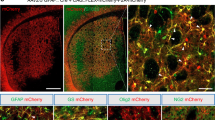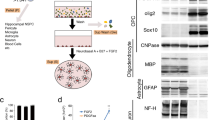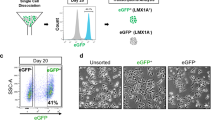Abstract
Intraventricular ependymal infection by adenoviruses expressing brain-derived neurotrophic factor (BDNF) and noggin is sufficient to induce the heterotopic recruitment of new medium spiny neurons to the adult neostriatum, from endogenous subependymal neural progenitor cells. This approach was found to slow disease progression and extend survival in an R6/2 mouse model of Huntington's disease (HD). However, the practical therapeutic value of this strategy is limited by the transient expression and immunogenicity of adenoviral vectors. In addition, it has been unclear whether sustained overexpression of BDNF and noggin would yield similarly sustained neuronal production and striatal recruitment, or whether progenitor depletion or tachyphylaxis might supervene to limit the therapeutic potential of this approach. To address these issues, we used adeno-associated virus serotype 4 (AAV4), an ependymotrophic vector that is neither immunogenic nor neurotoxic, to achieve sustained BDNF and noggin expression. Using AAV4, we found that BDNF and noggin achieved levels sufficient to initiate and maintain, for at least 4 months, ongoing neuronal addition to the neostriatum and olfactory bulb. Over this period, we noted no diminution of treatment-associated neuronal recruitment from resident progenitors. AAV4:BDNF and noggin-induced neuronal addition may thus provide a means to provide longlasting and persistent striatal neuronal replacement in conditions of striatal neuronal loss, such as HD.
This is a preview of subscription content, access via your institution
Access options
Subscribe to this journal
Receive 12 print issues and online access
$259.00 per year
only $21.58 per issue
Buy this article
- Purchase on Springer Link
- Instant access to full article PDF
Prices may be subject to local taxes which are calculated during checkout







Similar content being viewed by others
Abbreviations
- AAV4:
-
adeno-associated virus serotype 4
- BDNF:
-
brain-derived neurotrophic factor
- IRES:
-
internal ribosome entry site
- DARPP-32:
-
dopamine- and cyclic-AMP-regulated phosphoprotein of molecular weight 32 000 Da
- EGFP:
-
enhanced green fluorescent protein
- BrdU:
-
5-bromo-2′-deoxyuridine
- DCX:
-
doublecortin
- MSN:
-
medium spiny neuron
- OB:
-
olfactory bulb
- CNS:
-
central nervous system
- FMS:
-
fluorescent microsphere
- TUNEL:
-
terminal deoxynucleotidyl transferase (TdT)-mediated dUTP nick end-labeling
- ANOVA:
-
analysis of variance.
References
Doetsch F, Caille I, Lim DA, Garcia-Verdugo JM, Alvarez-Buylla A . Subventricular zone astrocytes are neural stem cells in the adult mammalian brain. Cell 1999; 97: 703–716.
Goldman SA, Luskin MB . Strategies utilized by migrating neurons of the postnatal vertebrate forebrain. Trends Neurosci 1998; 21: 107–114.
Luskin MB . Restricted proliferation and migration of postnatally generated neurons derived from the forebrain subventricular zone. Neuron 1993; 11: 173–189.
Lois C, Alvarez-Buylla A . Long-distance neuronal migration in the adult mammalian brain. Science 1994; 264: 1145–1148.
Zigova T, Pencea V, Wiegand SJ, Luskin MB . Intraventricular administration of BDNF increases the number of newly generated neurons in the adult olfactory bulb. Mol Cell Neurosci 1998; 11: 234–245.
Kornack DR, Rakic P . The generation, migration, and differentiation of olfactory neurons in the adult primate brain. Proc Natl Acad Sci USA 2001; 98: 4752–4757.
Sanai N, Berger MS, Garcia-Verdugo JM, Alvarez-Buylla A . Comment on ‘Human neuroblasts migrate to the olfactory bulb via a lateral ventricular extension’. Science 2007; 318: 393; author reply 393.
Curtis MA, Kam M, Nannmark U, Anderson MF, Axell MZ, Wikkelso C et al. Human neuroblasts migrate to the olfactory bulb via a lateral ventricular extension. Science 2007; 315: 1243–1249.
Pincus DW, Keyoung HM, Harrison-Restelli C, Goodman RR, Fraser RA, Edgar M et al. Fibroblast growth factor-2/brain-derived neurotrophic factor-associated maturation of new neurons generated from adult human subependymal cells. Ann Neurol 1998; 43: 576–585.
Roy NS, Benraiss A, Wang S, Fraser RA, Goodman R, Couldwell WT et al. Promoter-targeted selection and isolation of neural progenitor cells from the adult human ventricular zone. J Neurosci Res 2000; 59: 321–331.
Quinones-Hinojosa A, Sanai N, Soriano-Navarro M, Gonzalez-Perez O, Mirzadeh Z, Gil-Perotin S et al. Cellular composition and cytoarchitecture of the adult human subventricular zone: a niche of neural stem cells. J Comp Neurol 2006; 494: 415–434.
Arvidsson A, Collin T, Kirik D, Kokaia Z, Lindvall O . Neuronal replacement from endogenous precursors in the adult brain after stroke. Nat Med 2002; 8: 963–970.
Magavi S, Leavitt B, Macklis J . Induction of neurogenesis in the neocortex of adult mice. Nature 2000; 405: 951–955.
Nakatomi H, Kuriu T, Okabe S, Yamamoto S, Hatano O, Kawahara N et al. Regeneration of hippocampal pyramidal neurons after ischemic brain injury by recruitment of endogenous neural progenitors. Cell 2002; 110: 429–441.
Tattersfield AS, Croon RJ, Liu YW, Kells AP, Faull RL, Connor B . Neurogenesis in the striatum of the quinolinic acid lesion model of Huntington's disease. Neuroscience 2004; 127: 319–332.
Parent JM, Vexler ZS, Gong C, Derugin N, Ferriero DM . Rat forebrain neurogenesis and striatal neuron replacement after focal stroke. Ann Neurol 2002; 52: 802–813.
Jin K, LaFevre-Bernt M, Sun Y, Chen S, Gafni J, Crippen D et al. FGF2 promotes neurogenesis and neuroprotection in a transgenic mouse model of Huntington's disease. Proc Natl Acad Sci USA 2005; 102: 18189–18194.
Pencea V, Bingaman KD, Wiegand SJ, Luskin MB . Infusion of brain-derived neurotrophic factor into the lateral ventricle of the adult rat leads to new neurons in the parenchyma of the striatum, septum, thalamus, and hypothalamus. J Neurosci 2001; 21: 6706–6717.
Benraiss A, Chmielnicki E, Lerner K, Roh D, Goldman SA . Adenoviral brain-derived neurotrophic factor induces both neostriatal and olfactory neuronal recruitment from endogenous progenitor cells in the adult forebrain. J Neurosci 2001; 21: 6718–6731.
Bedard A, Gravel C, Parent A . Chemical characterization of newly generated neurons in the striatum of adult primates. Exp Brain Res 2006; 170: 501–512.
Chmielnicki E, Benraiss A, Economides AN, Goldman SA . Adenovirally expressed noggin and brain-derived neurotrophic factor cooperate to induce new medium spiny neurons from resident progenitor cells in the adult striatal ventricular zone. J Neurosci 2004; 24: 2133–2142.
Gomes WA, Mehler MF, Kessler JA . Transgenic overexpression of BMP4 increases astroglial and decreases oligodendroglial lineage commitment. Dev Biol 2003; 255: 164–177.
Lim DA, Tramontin AD, Trevejo JM, Herrera DG, Garcia-Verdugo JM, Alvarez-Buylla A . Noggin antagonizes BMP signaling to create a niche for adult neurogenesis. Neuron 2000; 28: 713–726.
Ross CA, Becher MW, Colomer V, Engelender S, Wood JD, Sharp AH . Huntington's disease and dentatorubral-pallidoluysian atrophy: proteins, pathogenesis and pathology. Brain Pathol 1997; 7: 1003–1016.
Bates GP, Mangiarini L, Mahal A, Davies SW . Transgenic models of Huntington's disease. Hum Mol Genet 1997; 6: 1633–1637.
Cho SR, Benraiss A, Chmielnicki E, Samdani A, Economides A, Goldman SA . Induction of neostriatal neurogenesis slows disease progression in a transgenic murine model of Huntington disease. J Clin Invest 2007; 117: 2889–2902.
Daya S, Berns KI . Gene therapy using adeno-associated virus vectors. Clin Microbiol Rev 2008; 21: 583–593.
Goncalves MA . Adeno-associated virus: from defective virus to effective vector. Virol J 2005; 2: 43.
McCarty DM, Young Jr SM, Samulski RJ . Integration of adeno-associated virus (AAV) and recombinant AAV vectors. Annu Rev Genet 2004; 38: 819–845.
Sevin C, Benraiss A, Van Dam D, Bonnin D, Nagels G, Verot L et al. Intracerebral adeno-associated virus-mediated gene transfer in rapidly progressive forms of metachromatic leukodystrophy. Hum Mol Genet 2006; 15: 53–64.
Bankiewicz KS, Forsayeth J, Eberling JL, Sanchez-Pernaute R, Pivirotto P, Bringas J et al. Long-term clinical improvement in MPTP-lesioned primates after gene therapy with AAV-hAADC. Mol Ther 2006; 14: 564–570.
Tenenbaum L, Chtarto A, Lehtonen E, Velu T, Brotchi J, Levivier M . Recombinant AAV-mediated gene delivery to the central nervous system. J Gene Med 2004; 6 (Suppl 1): S212–S222.
Wu Z, Asokan A, Samulski RJ . Adeno-associated virus serotypes: vector toolkit for human gene therapy. Mol Ther 2006; 14: 316–327.
Chiorini JA, Yang L, Liu Y, Safer B, Kotin RM . Cloning of adeno-associated virus type 4 (AAV4) and generation of recombinant AAV4 particles. J Virol 1997; 71: 6823–6833.
Liu G, Martins IH, Chiorini JA, Davidson BL . Adeno-associated virus type 4 (AAV4) targets ependyma and astrocytes in the subventricular zone and RMS. Gene Therapy 2005; 12: 1503–1508.
Biebl M, Cooper CM, Winkler J, Kuhn HG . Analysis of neurogenesis and programmed cell death reveals a self-renewing capacity in the adult rat brain. Neurosci Lett 2000; 291: 17–20.
Petreanu L, Alvarez-Buylla A . Maturation and death of adult-born olfactory bulb granule neurons: role of olfaction. J Neurosci 2002; 22: 6106–6113.
Yamaguchi M, Mori K . Critical period for sensory experience-dependent survival of newly generated granule cells in the adult mouse olfactory bulb. Proc Natl Acad Sci USA 2005; 102: 9697–9702.
Rochefort C, Gheusi G, Vincent JD, Lledo PM . Enriched odor exposure increases the number of newborn neurons in the adult olfactory bulb and improves odor memory. J Neurosci 2002; 22: 2679–2689.
Mouret A, Gheusi G, Gabellec MM, de Chaumont F, Olivo-Marin JC, Lledo PM . Learning and survival of newly generated neurons: when time matters. J Neurosci 2008; 28: 11511–11516.
Gleeson JG, Lin PT, Flanagan LA, Walsh CA . Doublecortin is a microtubule-associated protein and is expressed widely by migrating neurons. Neuron 1999; 23: 257–271.
Alexander JE, Hunt DF, Lee MK, Shabanowitz J, Michel H, Berlin SC et al. Characterization of posttranslational modifications in neuron-specific class III beta-tubulin by mass spectrometry. Proc Natl Acad Sci USA 1991; 88: 4685–4689.
Wolf HK, Buslei R, Schmidt-Kastner R, Schmidt-Kastner PK, Pietsch T, Wiestler OD et al. NeuN: a useful neuronal marker for diagnostic histopathology. J Histochem Cytochem 1996; 44: 1167–1171.
Gustafson EL, Ehrlich ME, Trivedi P, Greengard P . Developmental regulation of phosphoprotein gene expression in the caudate-putamen of rat: an in situ hybridization study. Neuroscience 1992; 51: 65–75.
Alexander GE, Crutcher MD . Functional architecture of basal ganglia circuits: neural substrates of parallel processing. Trends Neurosci 1990; 13: 266–271.
Peschanski M, Cesaro P, Hantraye P . Rationale for intrastriatal grafting of striatal neuroblasts in patients with Huntington's disease. Neuroscience 1995; 68: 273–285.
Katz LC, Burkhalter A, Dreyer WJ . Fluorescent latex microspheres as a retrograde neuronal marker for in vivo and in vitro studies of visual cortex. Nature 1984; 310: 498–500.
Dai Y, Schwarz EM, Gu D, Zhang WW, Sarvetnick N, Verma IM . Cellular and humoral immune responses to adenoviral vectors containing factor IX gene: tolerization of factor IX and vector antigens allows for long-term expression. Proc Natl Acad Sci USA 1995; 92: 1401–1405.
Liu G, Martins I, Wemmie JA, Chiorini JA, Davidson BL . Functional correction of CNS phenotypes in a lysosomal storage disease model using adeno-associated virus type 4 vectors. J Neurosci 2005; 25: 9321–9327.
Galvão RP, Garcia-Verdugo JM, Alvarez-Buylla A . Brain-derived neurotrophic factor signaling does not stimulate subventricular zone neurogenesis in adult mice and rats. J Neurosci 2008; 28: 13368–13383.
Henry RA, Hughes SM, Connor B . AAV-mediated delivery of BDNF augments neurogenesis in the normal and quinolinic acid-lesioned adult rat brain. Eur J Neurosci 2007; 25: 3513–3525.
Reumers V, Deroose CM, Krylyshkina O, Nuyts J, Geraerts M, Mortelmans L et al. Noninvasive and quantitative monitoring of adult neuronal stem cell migration in mouse brain using bioluminescence imaging. Stem Cells 2008; 26: 2382–2390.
Batista CM, Kippin TE, Willaime-Morawek S, Shimabukuro MK, Akamatsu W, van der Kooy D . A progressive and cell non-autonomous increase in striatal neural stem cells in the Huntington's disease R6/2 mouse. J Neurosci 2006; 26: 10452–10460.
Phillips W, Morton AJ, Barker RA . Abnormalities of neurogenesis in the R6/2 mouse model of Huntington's disease are attributable to the in vivo microenvironment. J Neurosci 2005; 25: 11564–11576.
Paine-Saunders S, Viviano BL, Economides AN, Saunders S . Heparan sulfate proteoglycans retain Noggin at the cell surface: a potential mechanism for shaping bone morphogenetic protein gradients. J Biol Chem 2002; 277: 2089–2096.
Urabe M, Ding C, Kotin R . Insect cells as a factory to produce adeno-associated virus type 2 vectors. Hum Gene Ther 2002; 13: 1935–1943.
Acknowledgements
Supported by NINDS R01NS53546 and R37/R01NS29813. We thank Eric Robbins and Michael Toner for technical support, and the Gene Therapy Core Facility of the University of Iowa for producing the AAV2/4-based viruses.
Author information
Authors and Affiliations
Corresponding authors
Ethics declarations
Competing interests
The authors declare no conflict of interest.
Additional information
Supplementary Information accompanies the paper on Gene Therapy website
Supplementary information
Rights and permissions
About this article
Cite this article
Benraiss, A., Bruel-Jungerman, E., Lu, G. et al. Sustained induction of neuronal addition to the adult rat neostriatum by AAV4-delivered noggin and BDNF. Gene Ther 19, 483–493 (2012). https://doi.org/10.1038/gt.2011.114
Received:
Revised:
Accepted:
Published:
Issue Date:
DOI: https://doi.org/10.1038/gt.2011.114
Keywords
This article is cited by
-
Hippocampal bone morphogenetic protein signaling mediates behavioral effects of antidepressant treatment
Molecular Psychiatry (2017)
-
Human Mesenchymal Stem Cells Genetically Engineered to Overexpress Brain-derived Neurotrophic Factor Improve Outcomes in Huntington's Disease Mouse Models
Molecular Therapy (2016)
-
Targeted gene transfer into ependymal cells through intraventricular injection of AAV1 vector and long-term enzyme replacement via the CSF
Scientific Reports (2014)
-
Gene Therapy for the Nervous System: Challenges and New Strategies
Neurotherapeutics (2014)
-
Identification, Cloning, and Functional Analysis of the TATA-Less Mouse FNDC5 Promoter During Neural Differentiation
Cellular and Molecular Neurobiology (2014)



